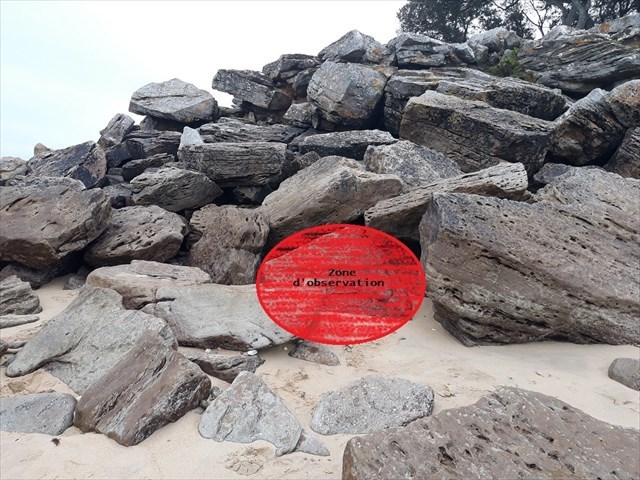 Les falaises de la Pointe Saint Pierre sont constituées d’énormes dalles gréseuses éocènes, souvent basculées suite à la sape de leur assise argilosableuse.
Les falaises de la Pointe Saint Pierre sont constituées d’énormes dalles gréseuses éocènes, souvent basculées suite à la sape de leur assise argilosableuse.
Ces grès conservent une paléoflore tropicale, des empreintes de végétaux, notamment de palmiers (feuilles, rares fruits).
Conditions de formation d’un fossile
Le fossile est ce qui reste après la disparition de la quasi-totalité de la matière qui constituait l’être vivant. Il faut des conditions exceptionnelles pour que le souvenir d’un organisme soit conservé après des centaines ou des millions d’années.
Cette particularité est le résultat d'un long processus que l'on nomme la fossilisation.
Il s'agit, en fait, d'un ensemble de transformations que subit un être vivant après sa mort et son enfouissement dans le sol. Il existe deux types de fossiles différents, à savoir, les fossiles directs qui sont les restes des êtres vivants et les fossiles indirects, qui sont les traces de sa vie ou de ses mouvements (empreintes, déjections etc...). Ce processus est un terme global qui en réalité peut désigner une minéralisation, une carbonisation, une incrustation, les ambres ou encore une momification (exceptionnellement rare).
A L'organisme meurt - B les fossiles sont enterrés
C Les sediments deviennent des roches - D Les roches sont exposées
 The cliffs of Pointe Saint Pierre are made of enormous Eocene sandstone slabs, often tilted following the undermining of their clayey base.
The cliffs of Pointe Saint Pierre are made of enormous Eocene sandstone slabs, often tilted following the undermining of their clayey base.
These sandstones retain a tropical paleoflora, imprints of plants, including palm trees (leaves, rare fruits).
Formation conditions of a fossil
The fossil is what remains after the disappearance of almost all of the matter that constituted the living being. Exceptional conditions are needed for the memory of an organism to be preserved after hundreds or millions of years.
This peculiarity is the result of a long process called fossilization.
It is, in fact, a set of transformations that a living being undergoes after its death and its burial in the ground. There are two different types of fossils, namely, the direct fossils that are the remains of living beings and the indirect fossils, which are the traces of his life or his movements (imprints, droppings, etc.). This process is a global term that can actually mean mineralization, carbonization, encrustation, amber or mummification (exceptionally rare).
!!! ATTENTION CACHE INACCESSIBLE A MAREE HAUTE !!!
!!! WARNING EARTHCACHE INACCESSIBLE HIGH TIDE !!!
Avant de vous y aventurer, consulter l'horaire des marées :
Before you go, check the tide schedule:
Horaires des marées
Questions pour valider cette earthcache :
D'après vos observations et à l'aide du descriptif :
Questions to validate this earthcache:
Based on your observations and using the description :
Question 0
Joindre à votre log (PAS à vos réponses) une photo de vous, votre GPS, votre GC perso ou tout autre objet de geocaching aux coordonnées de la cache (sans montrer les réponses !)
Les simples photos de paysage ou captures d'écran de votre position ne permettent de valider cette condition de log.
Cette tâche est obligatoire et autorisée par les guidelines mises à jour en juin 2019.
Attach to your log (NOT to your answers) a photo of you, your GPS, your personal GC or any other geocaching object at the posted coordinates (without spoiling the answers !)
The simple photos of the landscape or screenshot of your position do not validate this log condition.
This task is mandatory and allowed by the guidelines updated in june 2019.

Question 1
Quel type de fossile pouvez-vous observer ? Type A, B ou C ?
What type of fossil can you observe ? Type A, B or C ?
Question 2
S'agit-il de fossiles directs ou indirects ?
Are these direct or indirect fossils ?
Envoyez-moi vos propositions de réponses soit via mon profil, soit via la messagerie geocaching.com (Message Center) PUIS loguez cette cache "Found it", je vous contacterai en cas de problème.
Assurez vous de répondre à TOUTES les questions ! La condition principale pour loguer une Earthcache étant de répondre aux questions posées dans le descriptif, tout log "Found it" enregistré sans envoi préalable de vos propositions de réponses sera supprimé. Il en sera de même pour les logs enregistrés sans la photo requise.
Send me your proposals for answers either via my profile or via the geocaching.com messaging (Message Center) THEN log this cache "Found it", I will contact you in case of problem.
Make sure to answer ALL questions ! The main condition to log an Earthcache is to answer the questions asked in the description, any log "Found it" registered without prior submission of your proposals of answers will be deleted. It will be the same for logs saved without the required photo.